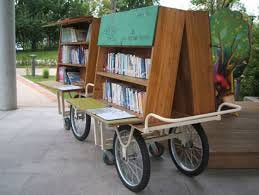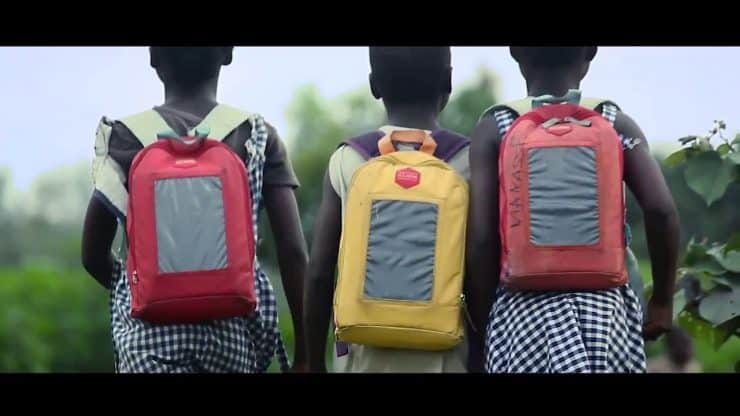Sunlight in a backpack brings books to life
African children find new ways to light up their homes and minds
James stood by his mobile library cart in a small Tanzanian village. The cart—a simple wooden rack on wheels—was packed with books, ready for eager young readers. Children could borrow books for free and return them a week later when James came around again.
As he entered the lane leading to the village’s assembly area, three little kids came running toward him, books in hand. James beamed. They had come to return their books and borrow new ones. Without a word, they thrust the books into his hands and dived into the cart, eyes scanning the shelves. One child rushed back, clutching a Famous Five book. James jotted the title in his register, then ran his finger down the list of the books the child had borrowed earlier. He noted with amusement that the same book had been borrowed three weeks earlier.
"Did you love it so much you wanted to read it again?" James asked with a smile.
The child shook his head. "I didn’t get a chance to read it last time," he admitted, a little embarrassed. "By the time I get home from school and finish my chores, it’s already dark. My village has no electricity. Reading at night is impossible."
The boy looked down and added sheepishly, as if it were his fault the Tanzanian government hadn’t supplied electricity to his village, "I rarely finish the books I borrow."
James sighed. He had faced the same problem as a child. He remembered the long walks to school—an hour and a half each way. Evenings were spent helping his parents with chores on their farm and at home. By the time he was done, it was already dark. James had always loved reading, and his mother encouraged him. She would lend him a kerosene lantern, and he would read by its dim, flickering light. But the lantern gave off thick, acrid smoke that made him cough. Still, he preferred that to not reading at all.
Over the next week, James spoke to other children who borrowed books. Many from this village and neighbouring ones confirmed what he had suspected—90% of them never finished their books because they had no light after sundown.
James wanted to solve this problem for children in other parts of Africa as well. As he kept mulling over the problem in his head, he felt an idea take shape in his mind. He couldn’t bring power grids and transformers. But he had an alternative solution.
Every week on The Lighter Side, I write a story based on real-life news around us. This week’s story is about a startup solving real-world problems in Africa—not the kind of "problem" that startups in India are tackling, like delivering 100 grams of jeera to my doorstep in 10 minutes.
This startup has transformed the way families and communities in Africa function after sundown. It has opened up the world of books for children and helped improve academic scores. Recently, it even received recognition from the UNDP’s (United Nations Development Programme) Funguo Innovation Programme.
Hope this story inspires you to do something like this, where you live.
As James walked home with his mobile library cart, he recalled a professor from his university. The man was like many of us, couldn’t function without his smartphone. Tanzania’s patchy electricity? A real headache for him.
But the professor was nothing if not resourceful. He had sewn a solar charger into the pocket of his jacket. As he strolled across campus, from home to class and back, the charger soaked up enough sunlight to keep his phone alive. Genius.
(Note: The equator passes through Tanzania = plenty of sunlight).
James wondered—could he do something similar for the kids? Sewing solar chargers into their uniforms? No good. Clothes needed washing. But school backpacks? Now that made sense. Kids walked two to three hours a day. Their bags would be in the sun the whole time.
He had an idea.
James scavenged discarded cement bags from the streets and began sewing flexible solar panels onto them. Here is how they work.
Each bag has a solar panel sewn into the outside of the backpack.
The solar panel is connected to a built-in rechargeable reading lamp inside the backpack.
When children wear their backpacks on their long walk to and from school, the bag’s solar panel charges the batteries of the reading light.
A fully charged lamp will provide up to eight hours of light.
Initially, James made the backpacks by hand, managing about 80 per month. He sold them for $4 to $8 each—the same amount a family would spend on kerosene for a month. But unlike kerosene, these backpacks provided power for much longer.
Villagers quickly saw the value, and the idea took off. Today, his startup, Soma Bags, has sold over 36,000 backpacks across Africa. And the demand is far greater.
James' venture has now gained the backing of the United Nations Development Programme (UNDP) and attracted investment from a Belgian company. This isn’t just a charitable effort—it’s a profitable business. Families already spending money on kerosene lamps can afford it, and Africa, where electricity is scarce, offers a massive market.

But as I read this story, I can’t help but wonder—what happens to the solar panels when they stop working? Usually, solar panels last about 20 years, but the version that James’ company uses is likely to last even lesser (2-3 years).
Will villages know how to responsibly discard the e-waste? Are we simply swapping air pollution from kerosene lamps for landfills filled with broken solar panels?
James’ idea tackles two problems at once—it cleans up discarded cement bags from Tanzanian streets and brings light to African homes. But if Soma Bags continues to grow, what comes next?
Right now, recycling old solar panels is tricky. Some parts can be reused, but many aren’t easy to separate, making recycling expensive. Solar power is better than no power and MUCH better than fossil fuels like coal and oil. But before we get excited by any clean energy ideas, we need to plan ahead to avoid creating a new problem—like too much e-waste.
Let’s hope James and his team find a way to collect and recycle these solar panels responsibly and inexpensively.
Other interesting stuff from Lighter Side
a) Podcast to listen to - This week, five children joined me on a podcast, along with storyteller Antara Goswami. Antara brings stories to life on stage using props, shadows, and her own wit and humour. She makes storytelling interactive—letting the audience change story endings, turn villains into heroes (and vice versa), and become part of the narration.
She also shared a great tip for aspiring writers: have someone else read your story aloud. It can give you a fresh perspective as an author. This episode had something for everyone—young and old alike—showing how storytelling can change the way we see people and their lives.
b) News update - A ceasefire was declared in Gaza a couple of weeks ago. But, of course, Donald Trump had other plans. After graciously suggesting that Israel and Palestine stop fighting, he has now come up with an even more groundbreaking idea—he wants to take over Gaza himself. Trump has suggested that two million residents kindly pack their bags and make way for luxury hotels and over-the-top extravagance. Because, naturally, what a war-torn region really needs is a golf course with a view of the rubble.
Unsurprisingly, the people of Gaza—along with Hamas, which governs the territory—aren’t exactly thrilled by this proposition. As a result, Hamas has announced that it won’t be releasing any more hostages to Israel. The fragile ceasefire is now teetering on the edge. Will the Middle East spiral back into war? Or will Trump get distracted by some bizarre idea—perhaps a plan to rename all the world’s rivers and oceans after himself? (Trump Black Sea, anyone?)
Meanwhile, if you need a refresher on how this whole Israel-Palestine conflict started, I’ve covered it in an earlier post.
(b) Book to buy - If you love books or are hunting for the perfect gift for someone aged 8-15, I’ve got a brilliant recommendation! Pick up The Lighter Side – Bag of Tales (2024). It’s packed with fascinating real-world stories, told through comic strips and engaging write-ups (much like this post—naturally, because I wrote the book!😉). These stories are nothing like the usual storybooks. They bring the real world to life in a fun and unexpected way.
So this time, ditch the usual picks and gift this book that’s TRULY different! 📖✨






